#foliose
Explore tagged Tumblr posts
Text


my new pretty Siren Pirate OC <3
her bra and tail are based on Foliose Coral!
3 notes
·
View notes
Text
can you imagine living on a coastline and the lichens are going crazy and you’re just like damn another day on the coastline with whatever that is I guess. millions of such cases as we speak
#i think moving to a place with lush fruiticose and foliose lichens would cure me#graph of all the antidepressants and their effectiveness but big lichens on top 80% effective clinically unprecedented#lichens
893 notes
·
View notes
Text





Xanthoparmelia sublaevis
images: source | source
#lichen#lichens#lichenology#lichenologist#mycology#ecology#biology#fungi#fungus#nature#symbiosis#symbiotic organisms#algae#Xanthoparmelia sublaevis#Xanthoparmelia#trypo#tw: trypophobia#I'm lichen it#lichen a day#daily lichen post#lichen subscribe#foliose lichen
123 notes
·
View notes
Text

Foliose lichens - Líquenes foliáceos
Sintra/Portugal (28/11/2024)
[Nikon D850; ∑150mm F2.8 EX DG OS HSM APO Macro with Circular Flash Nissin MF 18]
21 notes
·
View notes
Text

I forgot to post this because I finished it at like 12 and then I was too busy looking at what cool lichens I could add to her and then I ended up far down a Wikipedia rabbit hole at 2 am.
Anyways lichens are literally so cool because they are like THE symbiotic relationship. Like the 2 components most lichens have (Algae and fungi) are so intertwined that they are considered their OWN SPECIES?!?! THEIR OWN FAMILY?!?! Like when most people refer to symbiosis they refer to things like clown fish and anemones, which is a good example but both can survive somewhat without each other. But the algae and fungi that make up lichens are SO intertwined that they can be considered species of their own and are often ONLY seen with each other! That’s like if clown fish and anemones became so reliant on each other that they merged and became their own species. THAT IS SO AWESOME PEOPLE NEED TO TALK ABOUT THIS MORE PLEASE IVE BEEN HOLDING THIS INFORMATION IN FOR SO LONG AND NOBOY CARES WHEN I EXPLAIN HOW COOL THIS IS.
Ok deep breath guys sorry you had to deal with that infodump but if anyone ever asks me about plants/fungi/algae I will never shut up they are my special interests and I will never get tired of them.
Anyways I added some Foliose lichen to sequoia’s back instead adding those web thingys. I also tried to add some flavoparmelia caperata on the knot near the end of her wing since it’s one of my favorite kinds of lichen. I also added some of this one type of mushroom that usually appears on older trees but I forget its name.

Hehe haha anyways I’m totally normal about plants you guys should ask me about plants because I am sooo normal about them it’s crazy.
#wof#wings of fire#wof art#watercolor#leafwing#queen sequoia#sequoia wof#sequoia#lichen#moss#mushrooms#foliose lichen#hehe sorry#info dump#special interest#plants
33 notes
·
View notes
Text
girl help people on iNat are calling anything grey and lumpy Physcia stellaris again
#even if it's not remotely foliose#lichen#lichens#lichenology#inaturalist#girl help my post is incomprehensible
26 notes
·
View notes
Text
hi i want yall to know that Oakmoss and Cladonia are two of my favorite projects to have finished and I love looking at all of their children and seeing how they're loved
3 notes
·
View notes
Text
lichens r such a love story
#between the algae and the fungi#cause they're mutualistic#my favourite shape is foliose!#upd8#biologie
1 note
·
View note
Text
Thought people might want to see these specimens growing on my fence:
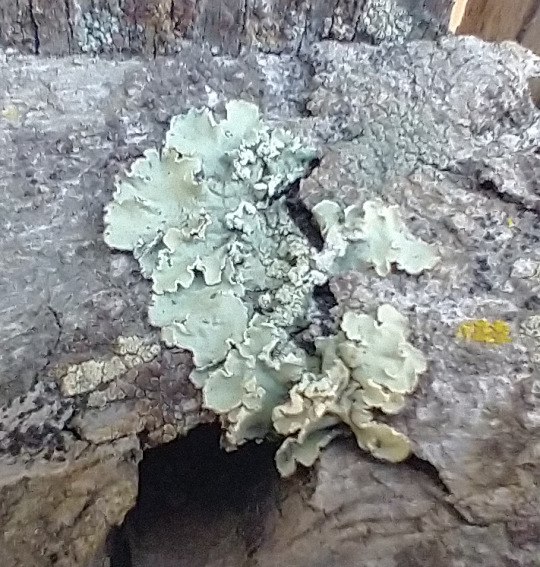
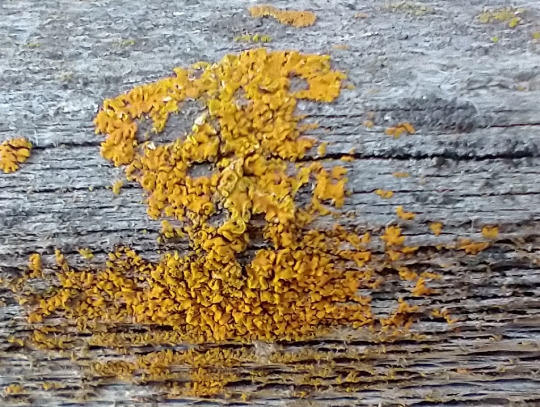
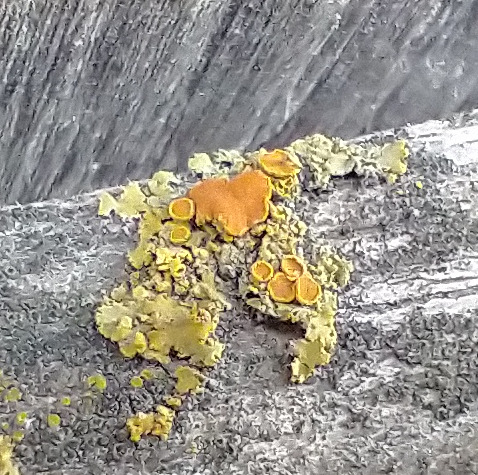
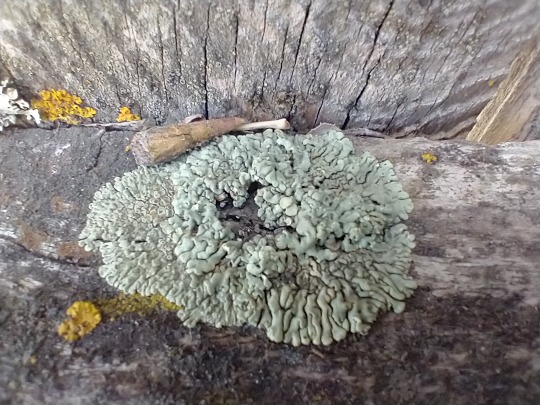
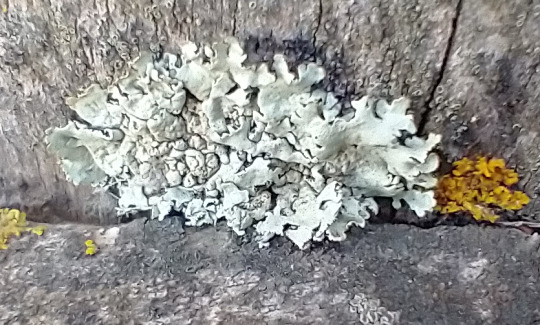
#mycology#lichen#wild fungi#foliose lichen#Visible podatia? I think?#Crustose lichen#If anybody would be interested in trying to identify these be my guest
0 notes
Note
could i request some foliose lichen? (if possible, just the lichen without the bark or anything but if not thats fine)
Thank you!


77 notes
·
View notes
Text
The Special Words for the Growth Forms of Lichen
The special words for forms of lichen are almost as good as the special words for the textures of ants. The Foliose, The Crustose and The fruticose. Areolate, Filamentous, Placodioid, Byssoid and Calicioid Who can forget Cladoniform and the Squamulose!
And must we mention the Gelatinous and Leprose?
163 notes
·
View notes
Text
tempted to make a lichen growth form tier list but in truth i appreciate all of them in their own ways.... fruiticose is lavish and interesting and genuinely kinda insane to me but only because i come from a place where all the lichens are crustose.... foliose lichens are also kinda wild and in my experience are laden with soridia on the edges and also sometimes can come out branched or tube-shaped or hairy on the edges which is wild, also i think its funny that they end up growing on top of each other on dense logs and stuff....crustose lichens have a special place in my heart because i grew up with them and i love how they cover the bark of trees and some of them are so flat you can barely tell its a lichen (Graphis scripta certified classic lichen moment)...... squamulose is a bit of a deep cut lichen moment but one of my favorite lichen species is squamulose (Psora decipiens ❤️💞🫶 spoiler alert: small and pink no less)......etc. just thinking about them today tbh
369 notes
·
View notes
Text

oc posting :3 a background i did the other day of my characters Georgiana (they/them, riding the horse), Ilieu (she/her, the little thing snuggled into their chest) and Foliose (she/her, the horse).
these 3 are minor characters in my story TUESDAY, but major characters in my heart. i wanted to try a different, more cell-colored style of background here, and I quite like the result!
the location is inspired by the southwest desert highlands in this fantasy western story. Malachite Pass is dense mountain terrain, and while this image is set in the early winter, let's pretend the blue flax flowers bloom here year-round, yes?
#quail art#quail oc#artists on tumblr#illustration#western art#desert landscape#landscape art#landscape illustration#made with krita#oc art#georgiana i love youuuu i love you georgiana#theyre one of those characters that really gets me weepy and i could talk about them for a while#their mind...oh their mind. its not your fault any of this happened and yet you had to make such difficult choices#just a horseman living out in the mountains with their cursed illegitimate child and completely regular dragonhorse#sigh i love TUESDAY
24 notes
·
View notes
Note
Hello there! I was out on a mushroom foray this morning and came across a lichen with an interesting rusty red color. I've never seen one quite like it and was wondering if you may have any ideas as to the species. The color is somewhat uneven, maybe it was originally a different color and changed due to some kind of stress? It was found growing on a fallen branch just off a woodland trail in southeast Texas. The underside of the thallus was black. Love your blog, thank you for making such informative posts!









Hi! It looks like some sort of Parmotrema (based off of lobe shape and the distinctive cilia around the margins) but the color is super weird. Likely this lichen is dead and what you are seeing is the result of secondary metabolites in the thallus breaking down or reacting to solar radiation or some other compound (some Parmotremas are used for making red/purple dyes). Or it could be the result of a lichenicolous fungi, or a stress color. I can't know for sure, but I have seen old, dead Parmelioid lichens turn a similar color when they die--just usually not that bright! Very cool! Thank you for sharing and for the kind words! And happy foraying!
53 notes
·
View notes
Text

Foliose and crustose lichens - Líquenes foliáceos e crustáceos
Cascais/Portugal (12/12/2024)
[NIkon D7100; Tamron 100/400mm Di VC USD F4,5-6,3]
15 notes
·
View notes
Note
Ok so I’m a little bit obsessed with your blog already (as of discovering it 5 whole seconds ago) 😅
I do 3D scanning as part of my job, but with a structured light scanner. I’ve thought about scanning a foliose or fruticose but haven’t attempted yet - or seen anyone else try scanning lichen - until now. To get those results with photogrammetry really is good going!
Also the capsule lids on your sphagnum moss are insane! If you have any macro setup recs or tips you don’t mind sharing, I would love to hear them. I have a decent macro lens, but still trying to find the right lighting option for super close-up work.
Thankyou for the kind words. <3
Photogrammetry: I feel like lichens are not an easy fit for current photogrammetry tech, but flat photographs frustratingly limited for lichen identification - it would be *so good* to have examples that you can view in the round. So it's worth trying to make it work.
I really want to make 3d models of tiny things: liverworts and smaller lichens stand to gain the most in terms of accessibility from being shown in 3d.
Macro: taking things home instead of shooting in the field is new to me, but nearly all of my photos are still done with available light - either on a windowsill or in a side-room with a glass roof. My macro lens is 100mm which is long enough that the camera overshadowing the subject is not usually an issue.
This is the first year I've done much > 1:1 macro work. I'm not sure what happens in the winter - it will be too dark to do anything at all on some days, so maybe I will be looking at alternative lighting setups soon...
17 notes
·
View notes